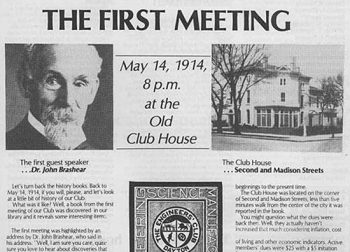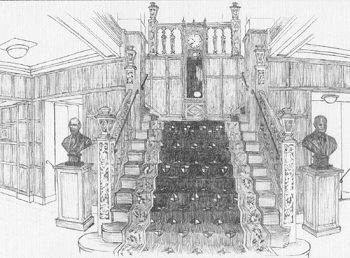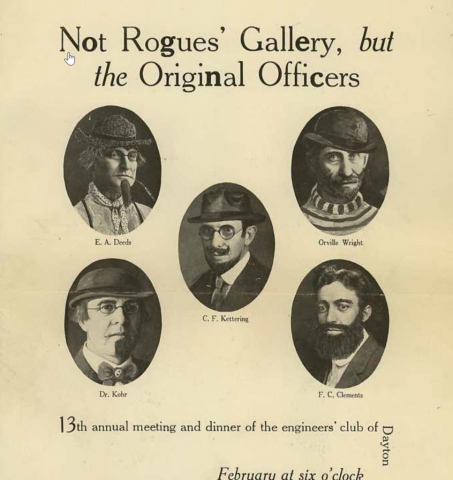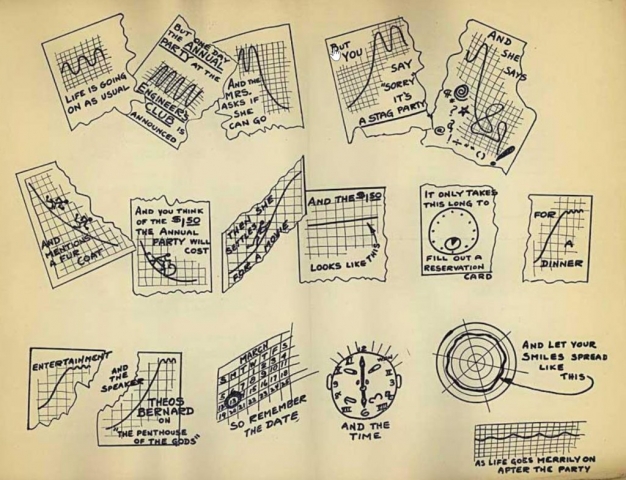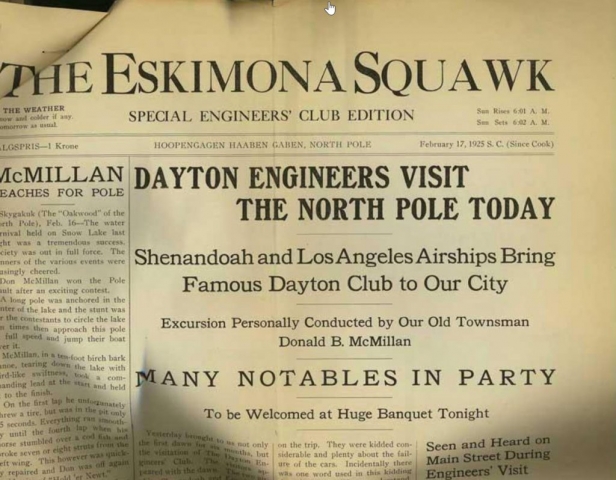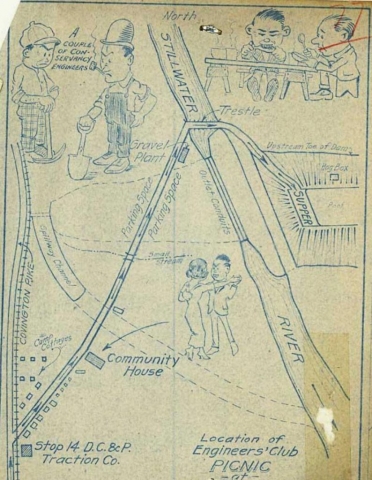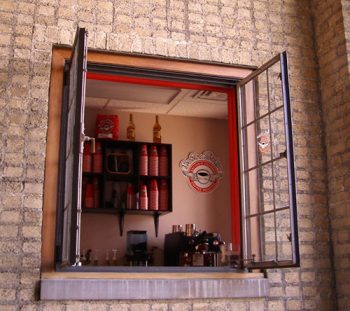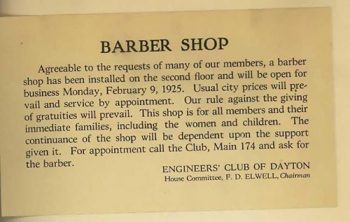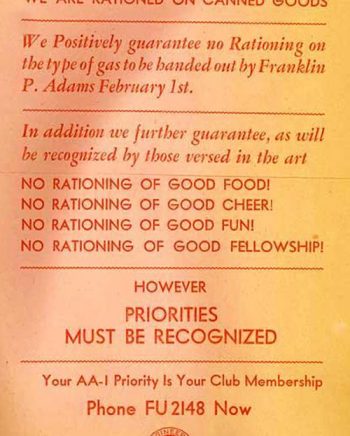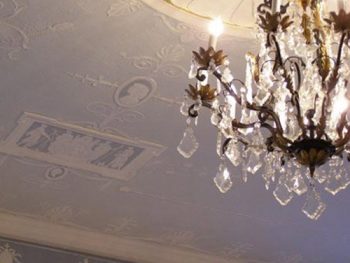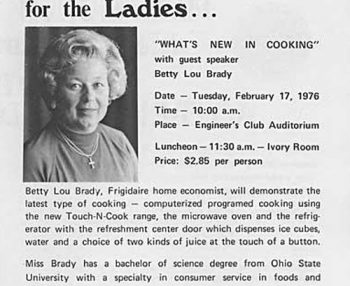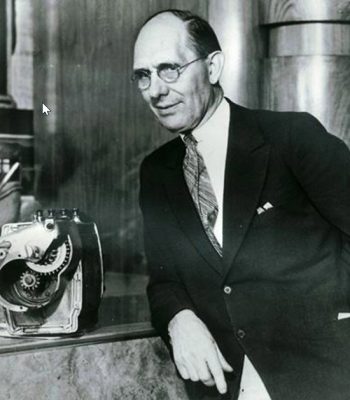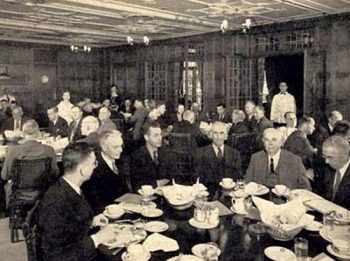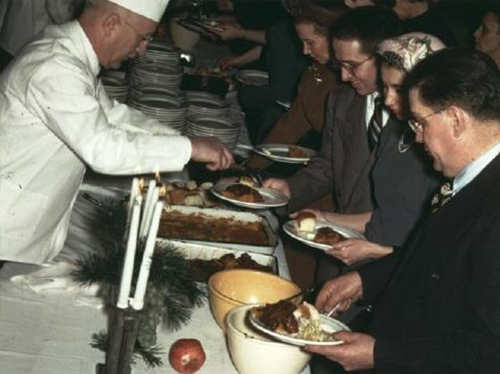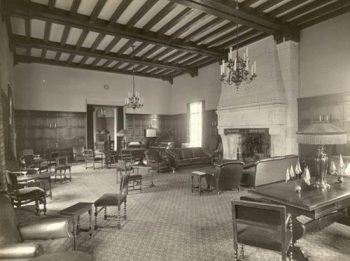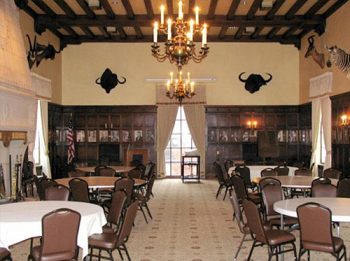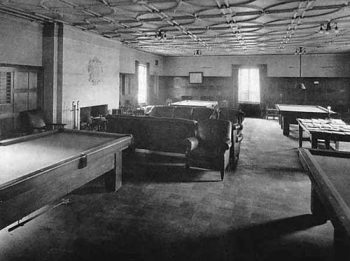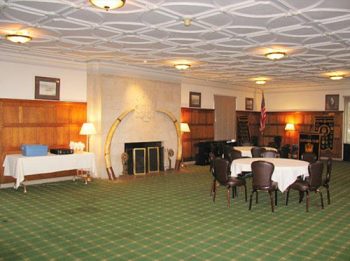Engineers Club History
From the Barn Gang to Industrial Empires
The history of our Club begins in 1914, when colleagues Colonel Edward A. Deeds and Charles F. Kettering were highly regarded in the scientific and engineering world for their passion and forward thinking.
Both were members of a group known as Barn Gang — creative thinkers who shared camaraderie and ideas as a gathering in an old barn on Deeds property.
At the time, they realized that Dayton was among the leading industrial cities in the United States due to the various highly-skilled engineers and technicians working in the city. So on February 20, 1914, Colonel Deeds called together a handful of key engineers and proposed to them the idea of establishing an Engineers Club of Dayton.
Colonel Deeds proposal was overwhelmingly approved and Colonel Deeds and Mr. Kettering arranged for the Engineers Club to meet at a Delco (Dayton Engineering Laboratories Company) owned property on the corner of Second and Madison Streets.
1914 and New Beginnings
(Click on the headers below to open new history and timeline descriptions)
- Building Blocks
- Education & Fellowship
- Monument Street
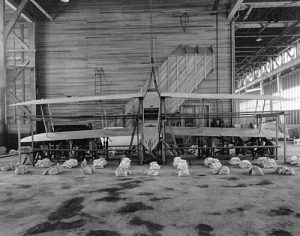
McCook Field, Photographer: C.P.I.
Thirty years prior, Thomas Edison had created the first industrial research lab. The idea spread like electricity. As Deeds put it, “men ought to hunt together,” and he and Kettering replicated this group concept in many forms.
Deeds helped create McCook Field, which grew into the Air Force’s main R&D lab, Wright-Patterson Air Force Base. Delco was sold to GM, founding the General Motors Research Corporation with Kettering in charge.
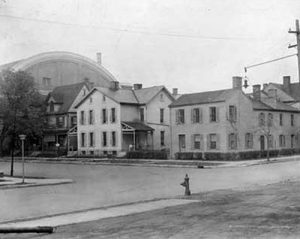 After their initial Delco success, Deeds and Kettering organized another group, a forum for engineers from across Dayton. On Feb. 20. 1914, they proposed an Engineers Club to the local technical community so that Dayton’s engineers and scientists could have the “educational advantages and fellowship facilities they had so greatly missed in their earlier days.”
After their initial Delco success, Deeds and Kettering organized another group, a forum for engineers from across Dayton. On Feb. 20. 1914, they proposed an Engineers Club to the local technical community so that Dayton’s engineers and scientists could have the “educational advantages and fellowship facilities they had so greatly missed in their earlier days.”
Members and potential employers (like Deeds and Kettering) could also evaluate one another more freely.
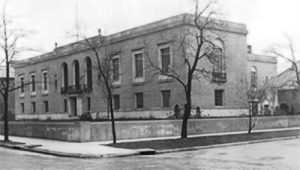 Initially the club met in a house owned by Delco a few blocks away at 2nd and Madison. But both club and Delco quickly outgrew the arrangement. Within five years a new club building was constructed at the current location 110 E. Monument — funded by Deeds and Kettering.
Initially the club met in a house owned by Delco a few blocks away at 2nd and Madison. But both club and Delco quickly outgrew the arrangement. Within five years a new club building was constructed at the current location 110 E. Monument — funded by Deeds and Kettering.
The site was near “ground zero” of the 1913 flood, and may have been available due to the resulting damage. Deeds’ involvement with The Miami Conservancy District, which built right across Jefferson St., may also have factored into the site selection.
By June 9, 1914, the number of Club members had reached 60. The membership increased in 1915, and to stimulate interest, Colonel Deeds and Mr. Kettering brought in distinguished speakers from all over the country to discuss various topics. Also in 1915, John H. Patterson, the founder and President of NCR, was made the first Honorary Member of the Club.
History shows the first annual meeting was held on June 1, 1915 — Professor Dexter S. Kimball was the speaker. Officers were elected that evening and Colonel Deeds was elected president of the Club for the 1915 – 1916 season.
In 1916, Colonel Deeds and Mr. Kettering needed to find a new home for the Club because Delco needed the property to build a new factory. The search was on for a new home. Finally, Deeds and Kettering decided upon the present-day location on the corner of Monument and Jefferson.
1918 The Engineers Club Building History
The local firm of Schenk and Williams designed the club building, and also supervised construction. The architects included the latest city steam heat and ventilation, with automated valves and regulators plus electric lighting.
They built well, knowing they would hear about any problems, as they were also members of the Club. Still, the work wasn’t perfect.
Long-term deficiencies in the roof truss design have led to repeated problems in recent years, addressed as funds become available. A Roof Fund has been established to plan for full replacement.
The reserved Orville Wright soon broke his perennial silence, speaking publicly at the opening on February 2nd, 1918. To get things rolling quickly, Deeds and Kettering paid for the building themselves in excess of $300,000 and subsidized its maintenance and operations for the first decade. By then membership had grown to the point that the club could be self-sufficient. Talk about self-starters!
The new club building incorporated a number of innovations. A built-in master vacuum cleaning system bore similarities to Orville Wright’s self-designed system at the Wright mansion, Hawthorn Hill. A pneumatic system synchronized the club’s clocks through a bellows, which advanced the minutes & hours via suction or puffs of air. Buttons for the servant enunciator network are still visible around the building.
Historic Engineers Club Videos
An important part of the Club and the members who helped bring it’s history into existence have been captured in the following videos, for your enjoyment.
The Wright Brothers, In Flight offers footage from aviation pioneer (and the Engineers Club fourth President), Orville Wright. Witness footage from some fo the world’s first public flights — including the earliest motion pictures ever taken from an airplane.
The 1935 film, Engineers Club of Dayton, takes a walking tour of the early facility. Enjoy a front row seat to history as founders Edward Deeds and Charles Kettering reminisce about the club. The reclusive Orville Wright makes a brief cameo!
To view our complete offering of digital media, please visit our Videos Page…
The Wright Brothers, In Flight
The Engineers Club of Dayton, 1935
A Rougue's Gallery
Check some of the printed materials from that era below. If the programs are any indication, the early history of the Engineers Club may have been a bit boisterous and less reverential towards its founders than today.
A highly technical party invitation is shown, and even the NCR art department created many playful Club announcements like this. Fake ads on the back include “Do it electrically — The Dayton Gas Company.”
Finally, a lighthearted blueprint invitation to a 1920 Engineers Club Picnic held at Englewood Dam, under construction as part of the Miami Conservancy District. Conservancy engineer Arthur E. Morgan, along with Conservancy Founders John Patterson and Edward A. Deeds, were early members of the Engineers Club.
(Click on the images below to see them enlarged.)
The Barber Shop
Aviation also found a pioneering home near the club. Directly across the river McCook Field became the first military aviation test field. There, early aviator Harold R. Harris, became the first to use a parachute successfully, landing in a grape arbor in North Dayton. This was fortuitous since he also later flew under the Main Street bridge…upside down!
The Club served unofficially as the initial “Officers Club” for McCook’s Army Air Corps officers. Along with Deed’s leadership, this interchange of aviators and engineers may have helped foster McCook as the Army’s chief R&D center for aviation, later to shift to nearby WPAFB.
In 1925 a cozy Barber Shop was installed upstairs off the Loggia porch, overlooking the McCook Airfield across the river. All members, wives and children could get clipped at “usual city prices.” It is unknown how many women trusted their locks to the club barber. The fastidious and private Orville Wright found this the perfect place to get a trim while observing the progress of aviation.
Today the Barber Shop serves up coffee to Engineers Club members.
Weathering the Great Depression
In 1929, the Club title transferred to the members with an estimated value of $405,000. The library by then held 3200 books.
With the onset of the depression, membership dropped by 10%, but the club survived — and by the 1936 had accepted its first female member, Maude Gardner.
During the same years, history would be written as Charles Kettering co-invented Freon 12 refrigerant gas, and several other members worked on related technology at the Frigidaire plant in town.
So it was fitting that air conditioning was installed in the club in 1937.
The lower level was developed as the French & Italian rooms. By the time of Pearl Harbor membership had climbed to 1000 members. Though war rationing restricted vacations and celebrations, the club found ways to provide some fun and relief to the growing membership working on the war efforts.
The Wedgewood Room
Originally the ladies’ lounge, the renamed Wedgewood Room features neoclassical decorations similar to the famous potter’s designs.
Josiah Wedgwood would have fit the Engineer’s Club surprisingly well. He was among the first tycoons of the industrial revolution, and pioneered marketing, manufacturing and industrial research — as well as the progressive treatment of his workers.
He also belonged to the Lunar Society, the first club for scientists and engineers.
Club membership grew more inclusive over the decades, welcoming women and minorities. Some traditional roles continued though, like this 1976 event “for the ladies” which introduced them to microwave cooking.
A Costly Crisis
- January of 1985 saw sudden flooding of the club building from top to bottom. A bitter cold snap broke a third floor water pipe, which flowed down through the floors, destroying the club’s last pool table and much carpeting, peeling paint but miraculously missing the south wing, library and wooden paneling in the Ivory Room. Fortunately the club carried good insurance. The adjuster estimated $30,000 damage initially.
- Other long-term problems would call for larger efforts. By 1996 the Foundation was positioned to accept tax-deductible donations for the required renovation. This involved revising the Foundation’s charter to allow for financial interaction with the club property and still remain within IRS regulations for a non-profit. An earlier success at the Masonic Temple pointed the way.
Soon a full $3.5 million building restoration was underway, a joint effort of Club’s Board of Governors and the Foundation called Renaissance 96. The restoration/modernization touched all areas of structure and grounds including structure integrity, assessing hazards like lead paint, a complete electrical modernization, enhanced security, and making a conversion to internal steam heat due to a DP&L phase-out downtown.
- Recent history and renovations include replacing the roof, upgrading third floor electrical system, restoring the Library, new carpets and drapes, fixing the dining room window walls and a full upgrade of the auditorium.
A Charitable MIssion
The non-profit Engineers Club of Dayton Foundation formed in 1972 with 501 (C) (3) tax-exempt status. Its original mission was to spread knowledge of science and engineering, sponsor public meetings and make grants to students. Beginning with $5400, within five years, its net worth grew to nearly $27,000.
By then, the Foundation was co-sponsoring yearly, all-day Edison-Science Youth Days for Dayton and area high school students — contributing to the Dayton Museum of Natural History and the Honors Seminar of Metropolitan Dayton, and making a $500 grant to a college Engineering student. A web search reveals that one recipient passed on the favor by teaching college math.
In more recent history, the Foundation obtained and supplemented an Engineering and Science Foundation grant. This would allow us to provide Math and Science Teaching Workshops to approximately 300 Miami Valley teachers, in 16 school systems.
Then & Now
From it’s inception to the current day, Dayton’s Engineering Club has evolved and flourished for more than a century. Along the way, the ECD continues to be a major player in the City’s core, and a valued institution moving into the future.
A visual look at just a few of the changes we have made can be seen below.
English Room in 2009
Today’s English Room hosts the Barn Gang luncheons, a variety of speakers and presentations. Photos of the Club’s past presidents (including Edward Deeds and Orville Wright), line the walls beneath our historical African hunting trophies. (Image courtesy of National Park Service/Ed Roach)
Wright Room in 2009
Originally a pool room, the Wright Room now serves as a mid-size meeting room and extra dining hall at the Engineers’s Club. The building’s different spaces were designed to accommodate groups of all sizes, from a handful to several hundred. (Photo courtesy of National Park Service/Ed Roach)
For more information about the Engineers Club of Dayton, please contact us by e-mail or phone, using the links below:

